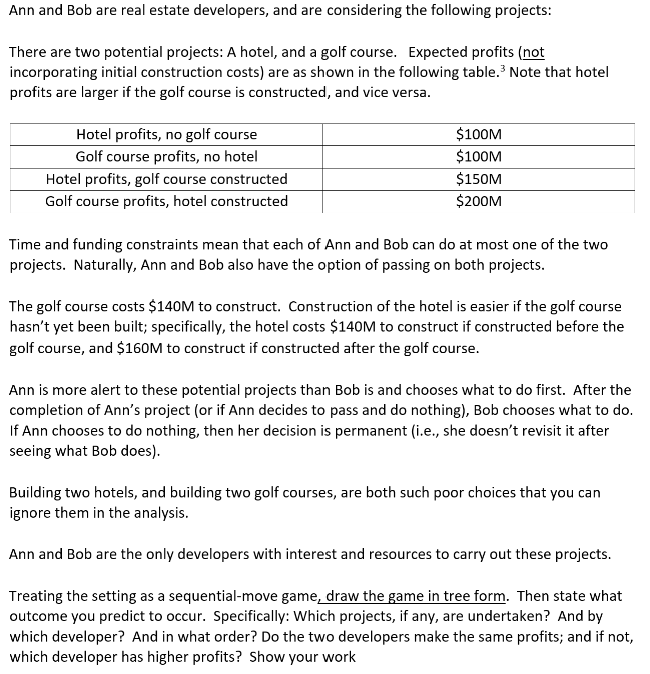Ann and Bob are real estate developers, and are considering the following projects: There are two potential projects: A hotel, and a golf course. Expected profits (not incorporating initial construction costs) are as shown in the following table. Note that hotel profits are larger if the golf course is constructed, and vice versa. Hotel profits, no golf course $100M Golf course profits, no hotel $100M Hotel profits, golf course constructed $150M Golf course profits, hotel constructed $200M Time and funding constraints mean that each of Ann and Bob can do at most one of the two projects. Naturally, Ann and Bob also have the option of passing on both projects. The golf course costs $140M to construct. Construction of the hotel is easier if the golf course
Ann and Bob are real estate developers, and are considering the following projects: There are two potential projects: A hotel, and a golf course. Expected profits (not incorporating initial construction costs) are as shown in the following table. Note that hotel profits are larger if the golf course is constructed, and vice versa. Hotel profits, no golf course $100M Golf course profits, no hotel $100M Hotel profits, golf course constructed $150M Golf course profits, hotel constructed $200M Time and funding constraints mean that each of Ann and Bob can do at most one of the two projects. Naturally, Ann and Bob also have the option of passing on both projects. The golf course costs $140M to construct. Construction of the hotel is easier if the golf course
Managerial Economics: A Problem Solving Approach
5th Edition
ISBN:9781337106665
Author:Luke M. Froeb, Brian T. McCann, Michael R. Ward, Mike Shor
Publisher:Luke M. Froeb, Brian T. McCann, Michael R. Ward, Mike Shor
Chapter5: Investment Decisions: Look Ahead And Reason Back
Section: Chapter Questions
Problem 5.4IP
Related questions
Question

Transcribed Image Text:Ann and Bob are real estate developers, and are considering the following projects:
There are two potential projects: A hotel, and a golf course. Expected profits (not
incorporating initial construction costs) are as shown in the following table. Note that hotel
profits are larger if the golf course is constructed, and vice versa.
Hotel profits, no golf course
$100M
Golf course profits, no hotel
$100M
Hotel profits, golf course constructed
$150M
Golf course profits, hotel constructed
$200M
Time and funding constraints mean that each of Ann and Bob can do at most one of the two
projects. Naturally, Ann and Bob also have the option of passing on both projects.
The golf course costs $140M to construct. Construction of the hotel is easier if the golf course
hasn't yet been built; specifically, the hotel costs $140M to construct if constructed before the
golf course, and $160M to construct if constructed after the golf course.
Ann is more alert to these potential projects than Bob is and chooses what to do first. After the
completion of Ann's project (or if Ann decides to pass and do nothing), Bob chooses what to do.
If Ann chooses to do nothing, then her decision is permanent (i.e., she doesn't revisit it after
seeing what Bob does).
Building two hotels, and building two golf courses, are both such poor choices that you can
ignore them in the analysis.
Ann and Bob are the only developers with interest and resources to carry out these projects.
Treating the setting as a sequential-move game, draw the game in tree form. Then state what
outcome you predict to occur. Specifically: Which projects, if any, are undertaken? And by
which developer? And in what order? Do the two developers make the same profits; and if not,
which developer has higher profits? Show your work
Expert Solution
This question has been solved!
Explore an expertly crafted, step-by-step solution for a thorough understanding of key concepts.
Step by step
Solved in 2 steps with 1 images

Knowledge Booster
Learn more about
Need a deep-dive on the concept behind this application? Look no further. Learn more about this topic, economics and related others by exploring similar questions and additional content below.Recommended textbooks for you

Managerial Economics: A Problem Solving Approach
Economics
ISBN:
9781337106665
Author:
Luke M. Froeb, Brian T. McCann, Michael R. Ward, Mike Shor
Publisher:
Cengage Learning

Managerial Economics: Applications, Strategies an…
Economics
ISBN:
9781305506381
Author:
James R. McGuigan, R. Charles Moyer, Frederick H.deB. Harris
Publisher:
Cengage Learning


Managerial Economics: A Problem Solving Approach
Economics
ISBN:
9781337106665
Author:
Luke M. Froeb, Brian T. McCann, Michael R. Ward, Mike Shor
Publisher:
Cengage Learning

Managerial Economics: Applications, Strategies an…
Economics
ISBN:
9781305506381
Author:
James R. McGuigan, R. Charles Moyer, Frederick H.deB. Harris
Publisher:
Cengage Learning
